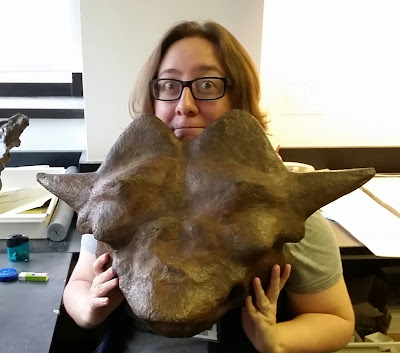It's hard for me to even believe this, but I've been writing
Pseudoplocephalus for over 5 years now. I'd been an avid reader of many science
blogs for a couple of years before I decided I wanted to try it out myself, and
I decided to jump in finally because I was going to be spending three and a
half months working and traveling around Korea, China and Mongolia back in 2010
on an NSERC-funded study abroad kind of thing. I figured that blog updates
would be the best way to show what I was doing to friends and family, and if I
liked it, I'd maybe keep writing about my research afterwards.
As I started writing here, I decided pretty quickly that I
wanted to use Pseudoplocephalus as a science outreach tool (as opposed to
keeping a grad school diary for my own benefits, etc.). At this point, my
general goals with the blog are:
1. Providing summaries of my research papers for nonspecialists,
especially for papers that are paywalled.
2. Showing what it's like to be a research
palaeontologist, for people who aren't scientists. (And, to be visibly female
while doing so.)
3. Promoting the research environments of the
various institutions I've worked at, to help increase the public's appreciation
of research in museums and universities.
4. Talking about other issues of interest to me,
like where palaeontology intersects with popular media and social justice
issues. For this goal, I'm interested in reaching both scientists and
nonscientists.
So, am I accomplishing any of those goals? I took part in
Paige Jarreau's science blog survey and some of you were kind enough to fill
out the survey, so here's a little bit of what I learned and how it relates to
what I'm doing.
How are people finding my blog?
At least in terms of the people who answered the survey,
most people seem to get to my blog via Facebook and Twitter, as well as the
blogrolls of other palaeontology sites. But, about 20% of the respondents had
only read one or two posts on my blog, suggesting that a fair number of people
stumble across it without necessarily being deeply embedded within the
palaeoblogosphere. Most of the survey respondents said they often seek out
information about science online, and nobody said they rarely or never seek it
out. Apparently, several of you were motivated to keep reading because you like
my writing style, so thanks! That is nice of you to say!
How are people using my blog?
Many of the survey respondents read Pseudoplocephalus to
keep up with the latest palaeo news and to find information that might not be
reported in traditional media, so, cool. A bunch of you also wrote in that you
come here to learn about ankylosaurs, so yay! Most of you do not come here for
emotional support, which is also good, because ankylosaurs are terrible
emotional support-givers. I recommend you check out Captain Awkward for the
top-shelf adulting advice. Overall, I'd say the way people seem to be using my
blog is in line with why I'm writing what I write.
Who are you people, anyway?
Several of the survey respondents noted that they know me
personally. I AM BEING WATCHED, THANKS ANONYMOUS FRIENDS FOR CREEPIN' ME OUT.
But seriously, that's not unexpected, and thanks creepy anonymous friends for
filling out my survey. Out of the 102 people who filled out the survey, 67%
identified as male and 31% identified as female. The biggest age cohort is
YOUNGER THAN ME which is giving me SOME KIND OF FEELINGS. Most of you are also
Caucasian, which means I need to do a better job of reaching out to non-white
people or making my blog an inviting space for underrepresented minorities in
science to come and have a look. I am not totally sure how to do this, so I
guess I have some research ahead of me!
I am also apparently in good blog company because lots of
you guys read blogs that I also like to read too, like Tetrapod Zoology,
SV-POW, Laelaps, and Love in the Time of Chasmosaurs. In that same question
(list up to three other science blogs that you read regularly), I noticed that
blogs written by dudes far, far outnumbered blogs written by ladies in the
blogs you submitted. Does this indicate that there are fewer blogs written by
women in the palaeoblogosphere (or at least dinoblogosphere)? Are people more
likely to think more highly of blogs written by men than women, or just more
likely to remember blogs written by men?
Lastly, it was interesting to see the self-identified
occupations you all listed – while it is not surprising that many of you are
grad students, palaeontologists, or other scientists, it was heartening for me
to see that non-scientists are also reading the blog, at least sometimes. Another
goal kind of accomplished!
So, am I meeting any of the general goals I keep in mind
when I'm writing here? Kind of. At least in terms of people who felt compelled
to complete the survey, I'm largely speaking to an audience of scientific
peers. BUT, I'm also reaching at least a few people who are not trained
scientists, and I suspect a lot more of the casual hits my blog receives each
day are not from dedicated scientists. Thanks again to everyone who
participated in the survey – many of you left awfully nice comments for me,
which really made me feel like this continues to be worth doing, so thanks for
the ego boost. It's been interesting to see who this blog is reaching and why
people are reading it! I don't know how long I'll keep this blog going, but I
don't have any intention of stopping soon and I'm glad I have an audience of
people who think it's worth following.
















































